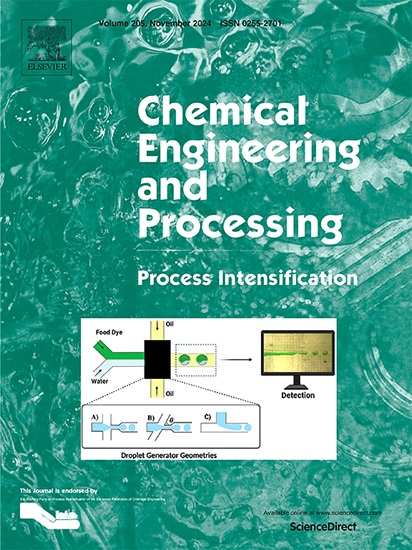Deep purification of trace fine particles in hydrogenated oil by microchannel separator
IF 3.8
3区 工程技术
Q3 ENERGY & FUELS
Chemical Engineering and Processing - Process Intensification
Pub Date : 2025-04-15
DOI:10.1016/j.cep.2025.110321
引用次数: 0
Abstract
The purification of hydrogenated oil using diatomaceous earth filtration separators has the high economic costs and material consumption. Previously, our team had achieved some industrial advantages by treating hydrogenated oils with microchannel separators; however there is still room for deep purification of micron-sized particulate pollutants.
In this study, a pilot-scale microchannel separator with a capacity of 1 m3/h was used for the deep purification of hydrogenated oil following the industrial-scale microchannel separator to enhance the its separation precision. Two separation media with equivalent diameters were used. The pilot microchannel separator was filled with a finer separating medium with an equivalent diameter of 0.3 ∼ 0.6 mm, which achieved an average turbidity reduction of 13.3 %. Moreover, the total particle number exhibited an average decrease of 43.4 %. The deep purification treatment extended the operation cycle of the downstream diatomite filter to 1.7 times its original duration. Using the microchannel separator, a projected reduction of 15 tons/year in solid waste discharge is anticipated for a petroleum resin process with a treatment capacity of 40 m³/h. This translates to an annual cost saving of 27 %.

微通道分离器深度净化氢化油中微量细颗粒
采用硅藻土过滤分离器提纯氢化油具有较高的经济成本和物料消耗。此前,我们团队利用微通道分离器处理氢化油,取得了一定的工业优势;然而,微米级颗粒污染物的深度净化仍有空间。本研究在工业规模微通道分离器的基础上,采用容量为1 m3/h的中试微通道分离器对加氢油进行深度提纯,以提高其分离精度。采用两种直径相等的分离介质。试验微通道分离器填充了更细的分离介质,当量直径为0.3 ~ 0.6 mm,平均浊度降低了13.3%。总颗粒数平均减少43.4%。深度净化处理使下游硅藻土过滤器的运行周期延长至原来的1.7倍。使用微通道分离器,预计石油树脂工艺的固体废物排放量将减少15吨/年,处理能力为40 m³/h。这相当于每年节省27%的成本。
本文章由计算机程序翻译,如有差异,请以英文原文为准。
求助全文
约1分钟内获得全文
求助全文
来源期刊
CiteScore
7.80
自引率
9.30%
发文量
408
审稿时长
49 days
期刊介绍:
Chemical Engineering and Processing: Process Intensification is intended for practicing researchers in industry and academia, working in the field of Process Engineering and related to the subject of Process Intensification.Articles published in the Journal demonstrate how novel discoveries, developments and theories in the field of Process Engineering and in particular Process Intensification may be used for analysis and design of innovative equipment and processing methods with substantially improved sustainability, efficiency and environmental performance.

 求助内容:
求助内容: 应助结果提醒方式:
应助结果提醒方式:


